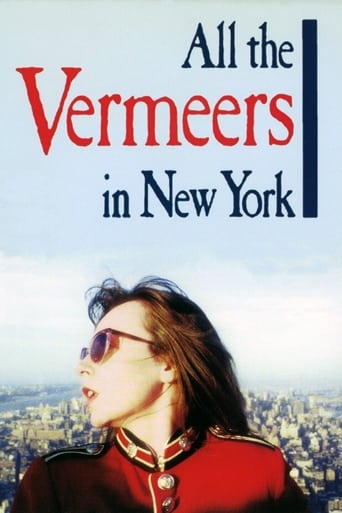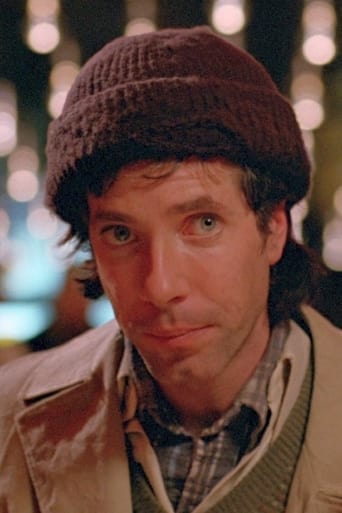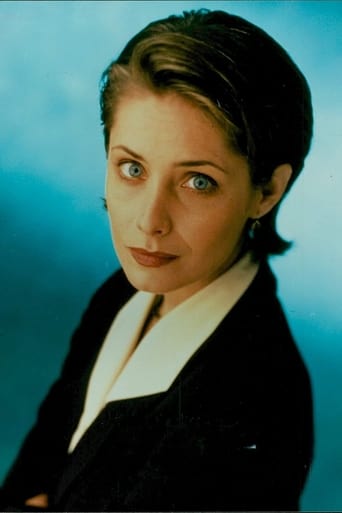

All the Vermeers in New York (1992)
A parable of the missteps of life enacted in the hothouse world of late 1980’s New York, in which the art market and the stock market each boomed, and in process spawned a smorgasbord of “yuppie” delusions which still persist. Anna, a French actress studying in New York, crosses paths with a successful stock-broker, Mark, standing before a Vermeer portrait at the Metropolitan, thence ensues a peculiar romance of missed meanings and connections, with tangential asides to the steaming arts world and stock market, loft-mate conflicts, and, perhaps, love. Wrapped up in their blindered worlds, Anna and Mark deflect away from their chances, leaving at the conclusion the wistful face of Vermeer’s portrait enigmatically asking questions. All the Vermeers in New York is a comedy of manners which, as gently as a Vermeer, looks beneath the skin of this time and place, and of these characters.
Watch Trailer
Cast
Reviews
Absolutely Fantastic
If the ambition is to provide two hours of instantly forgettable, popcorn-munching escapism, it succeeds.
A great movie, one of the best of this year. There was a bit of confusion at one point in the plot, but nothing serious.
There's no way I can possibly love it entirely but I just think its ridiculously bad, but enjoyable at the same time.
I want to echo what was said in a few above reviews about the litany of boring visuals that stretch across the length and breadth of this gawdawful movie. What I remember most clearly is that a large portion of the movie shows a view of the back of one or another character's head as that character looks at something, such as the sky from the WTC observation deck or a Vermeer painting in the Met. It's literally the "let's look at the back of someone's head" movie. Who thought that would be interesting?Then, for a climax, a character you couldn't care less about bleeds from his ear in a phone booth. When someone asks me what's the worst movie I ever saw, I often cite this one.
I'll use a scene from the movie to illustrate my problem with it: at some point we get a tracking shot starting from a girl reading a book, across her room over various objects of interest, bedsheets, Nike shoes thrown on the floor, a Cosmopolitan, then we hear stifled sobs off screen and we track back to the girl, now crying. The camera-work is beautiful, it's the slow sensual gliding that feels like choreography for a ballet ensemble or maybe like someone's hand slipping under the hem of a skirt, but I find the points of interest it brings together and the suggestions that emerge in this linking (in Jost's cinema as a whole or at least based on what I've seen) superficial and labored.Whereas in Frameup Jost's experimental technique got in the way of characters with a potentially interesting story waiting to be told, here I had the opposite reaction, interesting form beind sidetracked by flat uninteresting characters, possibly a story not worth the telling. The movie inhabits the lofts and galleries of Soho, the world of MoMa exhibitions and small coffee shops, its girls are sweet shy and cultured, they want to be actresses or sopranos and they care enough about the rainforest to call daddy and yell at him for bying stocks of gum companies in their name, and it's never quite clear where Jost sees himself in all this. His characters are self-involved and egopathic but his criticism against them is not as scathing (or as obvious) as in Frameup. The two male characters we see in the film are curious prototypes, the one is the angry artist throwing a temper tantrum because his agent won't lend him money, the other is the mature love interest, the stockbroker in the white horse come to sweep the young French girl off her feet.Of course it doesn't quite work this way, and it neither does for the movie. The story takes place in New York but it's not Woody Allen's Manhattan, it's not so much about finding or losing love, romance or even alienation, as it is about obligation, about our right to not be obliged to be anything if we don't want it, not even good or loyal or in love. The movie has the feeling of walking inside an art gallery, with some of that quality quiet and alert in the same time, with something cold and irrevocable like you're sitting on a bench and you can hear the echo of someone else's footsteps reverberating from a different room (they stop and it's quiet and then you can hear them again), punctuating the story with long neat tracking shots over polished mahogany floors and in endless dervish circles around marble pillars, with symmetrical shots arranged in orderly patterns, but Jost delivers his thing with perhaps a little too much minimalism, like he's too proud and 'left-field' to dramatize properly, so that even the premise of his movie slowly begins to hide from it.In the end Jost has to go looking for his premise. He finds it curled up in a dark corner of the museum, panting and naked, and he brings it kicking and screaming to the light. Our female protagonist begins narrating "the point of the movie" and Jost is literally speaking through her, hammering home an indifferent point in outrageous explanatory fashion, like all the subtlety of nuance that came before were but tools of their own destruction, so that we have 98% of a movie that is too vague and transparent and 2% that is anti-tank steel 5 inches thick. Maybe this is Jost the frustrated artist, who wants every last one in his audience to get him or maybe it was all an essay and he simply feels the need to conclude. From the tug-of-war between very carefully designed stylization and improv feel of acting and story, I think that Jost captures nice images, but he's not a storyteller.
Oh my GOD. This may just be the worst film I've ever seen. That it won awards anywhere seems to be a tribute to the "Emperor's New Clothes" school of film criticism. What a dreadful, film-school quality piece of junk. Endless shots of polished floors, marble-columned office-building lobbies, jet trails cutting across the clouds, all for nothing. NOTHING. And accompanied by a shatteringly harsh soundtrack.If anyone can tell me the point of the scene where the artist with the gambling problem tries to get an advance from a gallery owner, you will get a prize.Run, don't walk. Away, away, away!!
This film is visually very rich but the story and characters are fairly vaguely drawn. Jost seems content to concentrate on the surface and patterns of the lives which he is examining. The characters relationships seem more like diagrams of relationships than any naturalistic evocation. I don't necessarily think that there's anything wrong with that if formalist films are your bag you'll probably dig it. It reminded me of nothing more than old Warhol screen prints: beautiful to look at, but not very deep.


